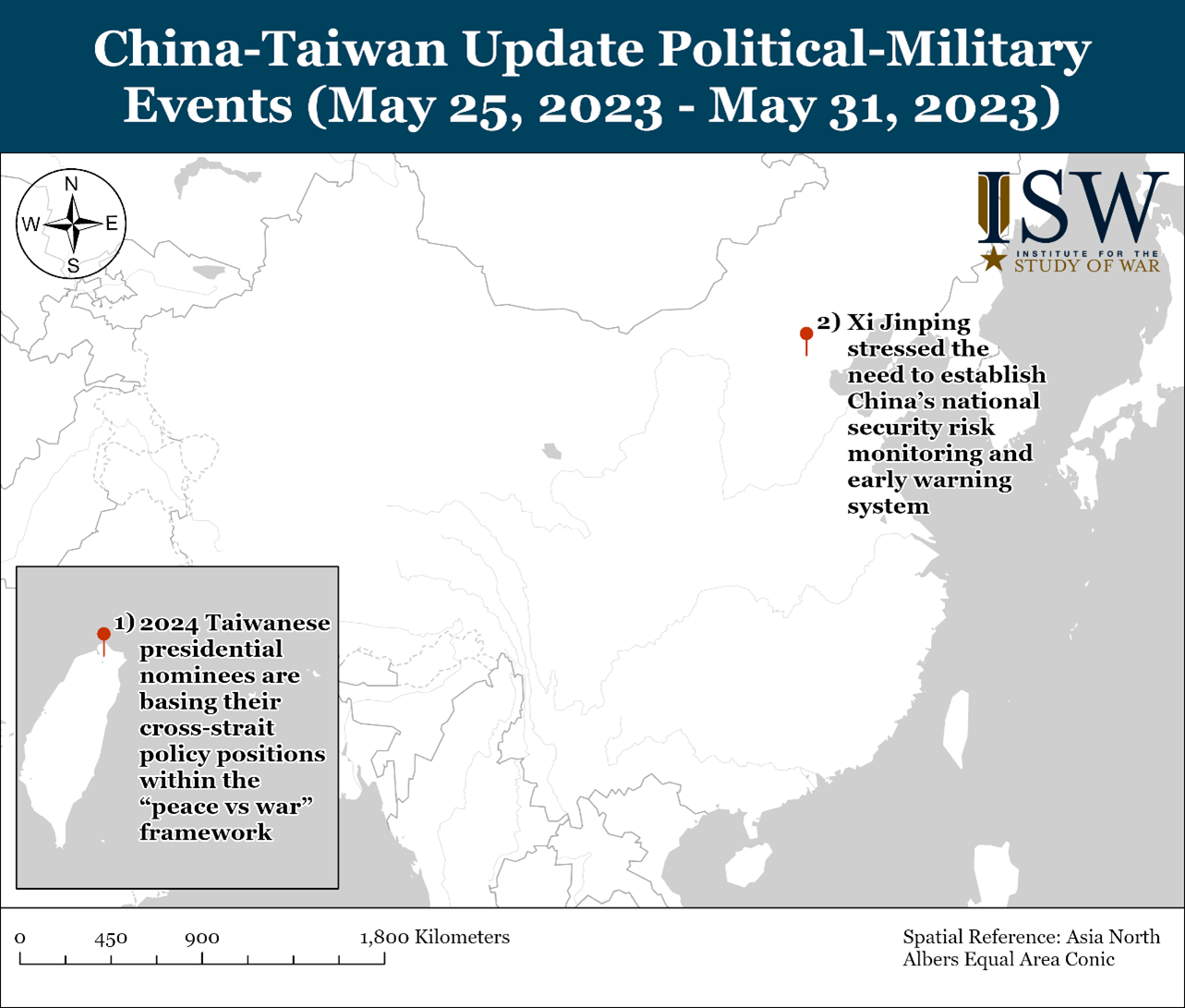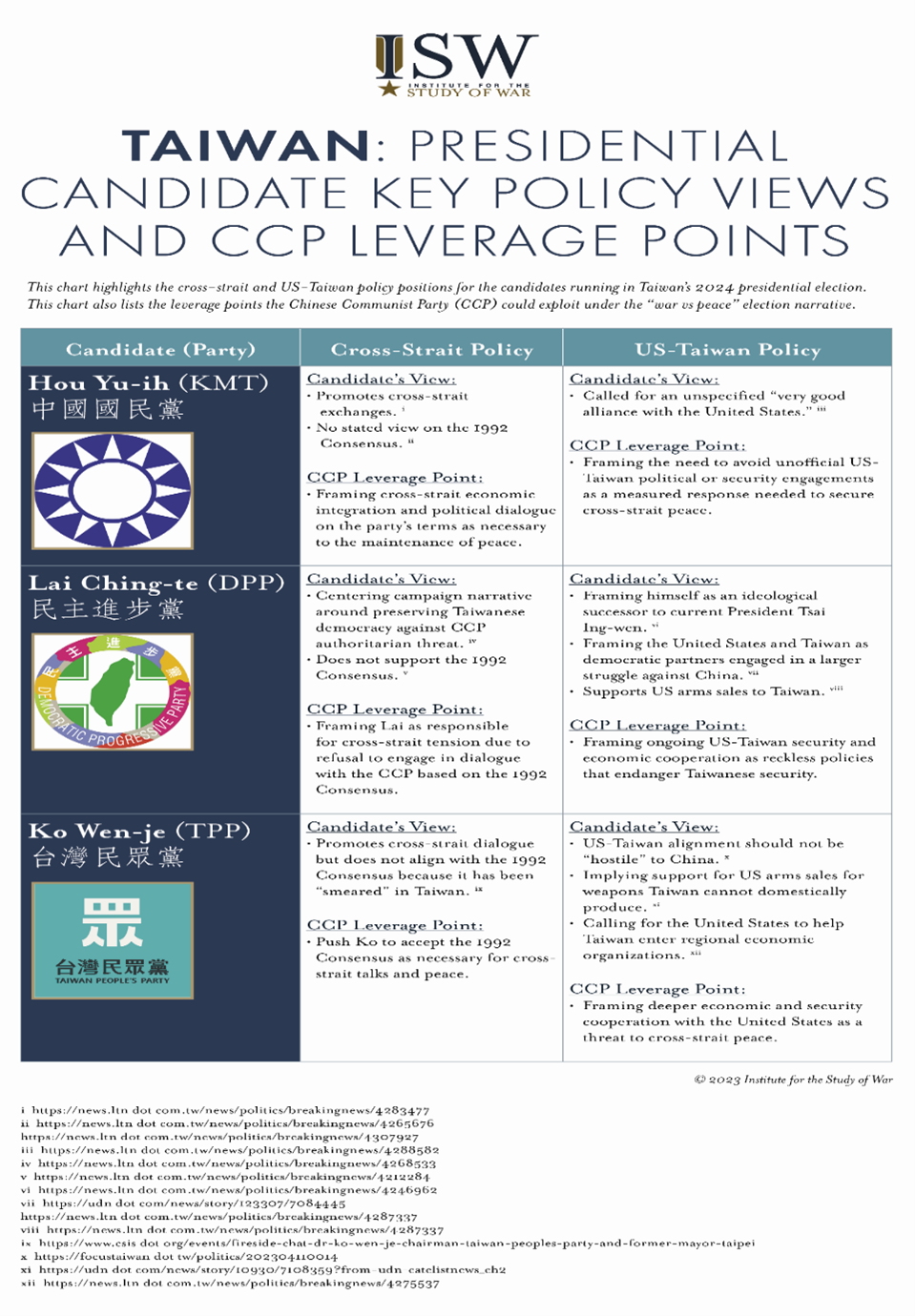 |
 |
China-Taiwan Weekly Update, June 2, 2023

China-Taiwan Weekly Update, June 2, 2023
Authors: Nils Peterson and Roy Eakin of the Institute for the Study of War
Editors: Dan Blumenthal and Frederick W. Kagan of the American Enterprise Institute
Data Cutoff: May 31, 2023
The China–Taiwan Weekly Update focuses on Chinese Communist Party paths to controlling Taiwan and relevant cross–Taiwan Strait developments.
Key Takeaways
- 2024 Taiwanese presidential candidates are basing their cross-strait policy positions within the “peace vs war” framework, which may provide China greater influence over their election narratives through the PRC-supported framework.
- Xi Jinping stressed the need to establish China’s national security risk monitoring and early warning system, which could serve as a tool to implement the CCP’s holistic security concept.
Taiwan Developments
This section covers relevant developments pertaining to Taiwan, including its upcoming January 13, 2024 presidential and legislative elections.
Elections
The Taiwanese (Republic of China) political spectrum is largely divided between the Democratic Progressive Party (DPP) and the Kuomintang (KMT). The DPP broadly favors Taiwanese autonomy, Taiwanese identity, and skepticism towards China. The KMT favors closer economic and cultural relations with China along with a broader alignment with a Chinese identity. The DPP under President Tsai Ing-wen has controlled the presidency and legislature (Legislative Yuan) since 2016. This presidential election cycle also includes the Taiwan People’s Party (TPP) candidate Ko Wen-je who frames his movement as an amorphous alternative to the DPP and KMT. It is normal for Taiwanese presidential elections to have third party candidates, but none have ever won. The 2024 Taiwan presidential and legislative elections will be held on January 13, 2024 and the new president will take office in May 2024. Presidential candidates can win elections with a plurality of votes in Taiwan.
Terminology
1992 Consensus: a disputed cross-strait policy formulation supported in different formations by the CCP and KMT that acts as a precondition to cross-strait dialogue. The DPP does not support the 1992 Consensus.
One-China Principle: a formulation created by the People’s Republic of China (PRC) claiming that the PRC is the sole legal representative of China in the international arena and that Taiwan is a part of China.[1] The ROC (Taiwan) and United States do not recognize the one-China principle. The United States operates under its own one-China policy that acknowledges the PRC’s position towards Taiwan without accepting PRC territorial claims over the island.
2024 Taiwanese presidential candidates are basing their cross-strait policy positions within the “peace vs war” framework, which may provide China greater influence over their election narratives through the PRC-supported framework. ISW previously assessed that framing the election as a choice between war and peace provides the CCP with leverage points over each candidate.[2] The leverage points could enable the CCP to influence how the candidates form their cross-strait and US-Taiwan policies, as well as how they present those policies to domestic and international audiences in the post-election period. The PRC frequently frames the policies of Taiwan’s ruling Democratic Progressive Party (DPP) as a major source of cross-strait tension that could lead to war.[3] KMT nominee Hou Yu-ih and TPP nominee Ko Wen-je are both promoting cross-strait dialogue and engagement, which may allow the CCP to promote economic and political dialogue under their leadership. DPP nominee Lai Ching-te (William Lai) countered the larger ”peace vs war” framing by promoting rhetoric that emphasizes the protection of Taiwan’s sovereignty. Each candidates’ statements respond to the prevalence of the ”peace vs war” framework in the Taiwanese election cycle.
KMT presidential candidate Hou Yu-ih endorsed former President Ma Ying-jeou's cross-strait policy approach, which signals continuity in the KMT’s cross-strait policy. Hou praised Ma’s cross-strait policy as “peaceful and stable.”[4] He signaled his view that close cross-strait economic and political engagement, such as that which occurred under Ma’s leadership from 2008-2016, is necessary to the return of cross-strait stability.[5] Hou’s praise of Ma’s cross-strait policy signals his acceptance of the 1992 Consensus even as he refuses to clarify his views of the consensus, given its unpopularity among a majority of Taiwanese voters.[6]His acceptance of the 1992 Consensus shows that he will not stray from the KMT’s existing approach to cross-strait relations, which frames cross-strait engagement as beneficial to Taiwan’s economic interests and overall stability. This is in line with the views among the ”dark blue” bases of support within the KMT and the CCP
Hou’s statements signal the KMT’s internalization of the view that close engagement with China is needed to secure Taiwan’s stability and cross-strait peace. His association with Ma highlights the KMT’s view that Ma’s cross-strait policy remains an influence cross-strait policy influence within the KMT. Hou’s open support for Ma’s cross-strait policy complements existing leverage points by providing the CCP with ideological synergy and points of agreement regarding the general direction of cross-strait relations that could be leveraged during a hypothetical Hou presidency. This ideological synergy could operationalize shared desires for economic engagement and dialogue with specific engagement and initiatives during a Hou presidency.
DPP presidential nominee Lai Ching-te (William Lai) opposed framing the upcoming Taiwanese presidential election as a choice between war and peace. ISW previously assessed that the “peace vs war” narrative could frame Lai’s refusal to accept the 1992 Consensus as a major source of cross-strait tension.[7] Lai warned on May 28 that Taiwanese political parties “unintentionally or intentionally” repeat CCP-supported rhetoric in framing the 2024 Taiwanese election as a choice between war and peace.[8] Lai instead merged calls for peace with calls for the protection of Taiwan‘s sovereignty by promoting “peace and sovereignty.[9] He also stated that certain measures intended to promote cross-strait peace, such as accepting the 1992 Consensus, would ”sacrifice sovereignty” and lead to ”fake peace.”[10] This rhetoric aligns with Lai’s existing framing of the 2024 election as a choice between democracy and authoritarianism.[11]
Lai’s rhetoric challenges the “peace vs war” narrative by re-orienting the discussion around the well-being of Taiwan’s sovereignty. This may allow voters to re-think their view of the election by re-framing the DPP as a party that will defend Taiwan’s sovereignty and democracy from persistent CCP threats. By doing so, Lai can frame the CCP as the source of existing threats towards Taiwan. Lai provides this counter-argument at a time when a majority of Taiwanese say they agree with Taiwanese President Tsai Ing-wen's cross-strait policy, which emphasizes the protection of Taiwanese sovereignty.[12]
TPP presidential nominee Ko Wen-je emphasized the need for cross-strait dialogue, which aligns with the need for immediate engagement with the CCP at the core of the “peace vs war” narrative. Ko contributed to the framing of the upcoming election as a choice between war and peace by blaming the DPP for the lack of cross-strait dialogue and saying that the chances of a cross-strait conflict will “reduce” under his leadership.[13] This type of rhetoric implies that immediate dialogue is needed to secure cross-strait peace and stability. Ko framed himself as a candidate that can both stabilize cross-strait relations through dialogue and preserve Taiwanese autonomy by calling for “cross-strait peace and Taiwanese autonomy” on May 28.[14] This rhetoric resembles that of DPP nominee Lai Ching-te (William Lai), who called for a Taiwanese policy approach emphasizing “peace and sovereignty.”[15] Ko differentiates himself from Lai by blaming the DPP for failing to engage in cross-strait dialogue and stressing the need for immediate cross-strait dialogue.[16] Ko has not mentioned existing barriers to cross-strait dialogue, such as the CCP’s emphasis on Taiwanese participants recognizing formulations like the 1992 Consensus.[17] Ko did not specify how his vision of cross-strait dialogue would emerge and even said that Taiwan could emphasize its “freedom and democracy” in talks where China emphasizes its “One Country, Two Systems” post-unification formula.[18] Rhetoric involving “democracy and freedom” aims to appeal to Taiwanese voters concerned about the future of Taiwan’s democracy amid the CCP’s military threats against Taiwan.
China Developments
This section covers relevant developments pertaining to China and the governing Chinese Communist Party (CCP).
Xi Jinping stressed the need to establish China’s national security risk monitoring and early warning system, which could serve as a tool to implement the CCP’s holistic security concept. This is a low confidence assessment. Xi approved a document on accelerating the “Construction of a National Security Risk Monitoring and Early Warning System” at the meeting of the National Security Commission on May 30.[19] His comments fit the trend of the party viewing itself in a protracted struggle in a more hostile geopolitical environment coming out of the 20th Party Congress in October 2022. An early warning system that indicates when the party is losing ground in different areas broadly aligns with the CCP’s holistic security concept, which involves cultural influence, economic power, military strength, and party control of domestic society. This includes preventing mass protests, such as those that occurred from November to December 2022 in response to societal discontent stemming from the zero-Covid policy.
The CCP policy guidance to diversify China’s supply chain indicates the party views food supplies, particularly pork, as part of a long-term protracted struggle with hostile powers, including the United States. The party claims China is self-sufficient in grains but relies on imports for proteins, such as soybeans, meat, and milk.[20] The CCP policy guidance aims to increase self-reliance in these import dependent sectors.[21] Xi Jinping reiterated this position in a party journal article on May 30 by stating that the party faces a challenging strategic environment where it must be prepared to face “high winds” and “turbulent waves.”[22]
Xi included food security as a necessity in this strategic environment, which he aims to achieve via the “big food concept.”[23] The concept calls for cultivating food sources beyond limited arable land via means such as greenhouses and intensive livestock breeding.[24] The absence of rhetoric about future geopolitical tranquility in CCP state media and journals indicates that Xi views the party as in a protracted period of struggle against hostile powers for the foreseeable future.
Recent food shortages and associated popular discontent during China’s zero-Covid policy make food security a sensitive issue for the regime. The party derives legitimacy from addressing the livelihood concerns of its people rather than through democratic institutions.[25] Food-related discontent during the pandemic, in part, led the party to fire three Shanghai party officials in April 2022.[26] Pork is particularly important as China accounts for over half the world’s consumption annually and maintains a strategic pork reserve of several hundred thousand tons.[27] The ongoing construction of high-rise buildings housing hog farms to increase Chinese domestic pork production serves the larger goal of implementing the ”big food concept” and partly decreases the country’s reliance on foreign protein imports.[28]
[1] https://www.fmprc dot gov.cn/eng/wjb_663304/zwjg_665342/zwbd_665378/202208/t20220812_10742117.html
[2] https://www.understandingwar dot org/backgrounder/china-taiwan-weekly-update-may-26-2023
[3] dot com.cn/rmrbhwb/html/2023-06/01/content_25991163.htm
https://www.globaltimes dot cn/page/202304/1289968.shtml
[4] https://udn dot com/news/story/123514/7193382?from=udn-catelistnews_ch2
https://news.ltn dot com.tw/news/politics/breakingnews/4314446
[5] https://news.ltn dot com.tw/news/politics/breakingnews/4314446
https://udn dot com/news/story/123514/7193382?from=udn-catelistnews_ch2
[6] https://www.taiwannews dot com.tw/en/news/4866215
[7] https://www.understandingwar dot org/backgrounder/china-taiwan-weekly-update-may-26-2023
[8] https://news.ltn dot com.tw/news/politics/paper/1585525
[9] https://www.storm dot mg/article/4799148
https://news.ltn dot com.tw/news/politics/breakingnews/4317809
[10] https://www.taiwannews dot com.tw/en/news/4903344
https://news.ltn.com dot tw/news/politics/breakingnews/4314925
[11] https://news.ltn dot com.tw/news/politics/breakingnews/4268533
[12] https://www.mac dot gov.tw/News_Content.aspx?n=05B73310C5C3A632&sms=1A40B00E4C745211&s=08BC9CAD744BBB8D
[13] https://www.storm dot mg/article/4780293
https://news.ltn dot com.tw/news/politics/breakingnews/4311960
[14] https://news.ltn dot com.tw/news/politics/paper/1585528
[15] https://news.ltn dot com.tw/news/politics/breakingnews/4317809
https://www.storm dot mg/article/4799148
[16] https://www.storm dot mg/article/4780293
https://news.ltn dot com.tw/news/politics/breakingnews/4311960
[17] http://tr.china-embassy dot gov.cn/tur/sgxw/202305/t20230520_11080535.htm
[18] https://news.ltn dot com.tw/news/politics/breakingnews/4316046
[19] http://www.qstheory dot cn/yaowen/2023-05/30/c_1129657412.htm
[20] http://www.qstheory dot cn/dukan/hqwg/2023-05/26/c_1129646736.htm
[21] http://www.qstheory dot cn/dukan/hqwg/2023-05/26/c_1129646736.htm
[22] http://www.qstheory dot cn/yaowen/2023-05/30/c_1129657412.htm
[23] The characters for ”big food concept” are 大食物观.
[24] http://www.qstheory dot cn/dukan/qs/2023-03/15/c_1129432282.htm
[25] https://www.washingtonpost.com/world/2022/09/12/china-covid-lockdown-xinjiang-food/
[26] https://apnews.com/article/covid-health-china-beijing-shanghai-742307460a9a97375723b2cc3b065cfe
[27] https://www.nytimes.com/2023/02/08/business/china-pork-farms.html
https://www.nytimes.com/2019/10/07/business/china-strategic-pork-reserve.html
[28] https://www.nytimes.com/2023/02/08/business/china-pork-farms.html

